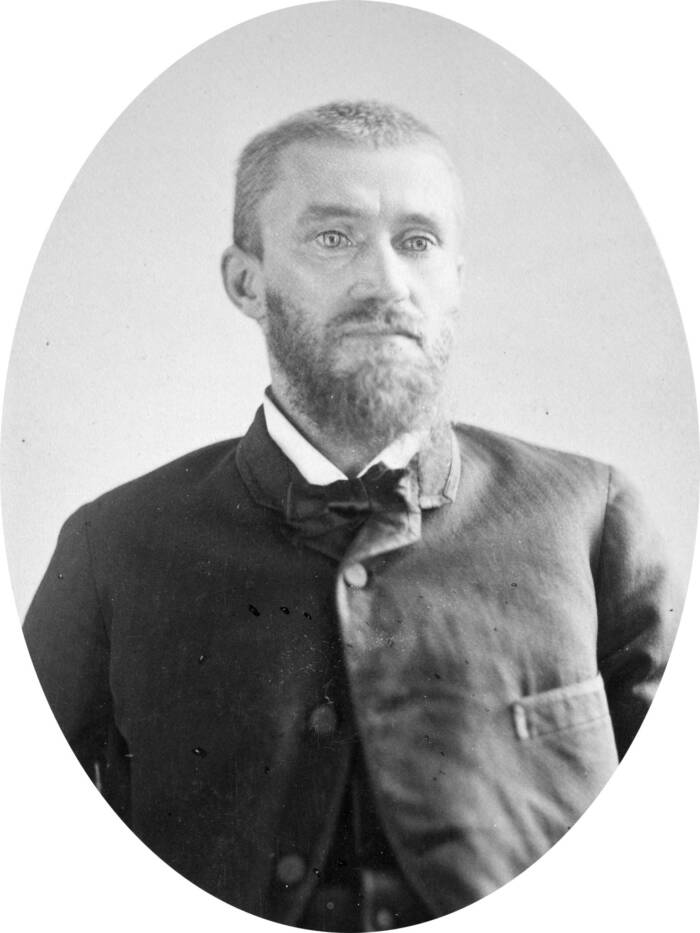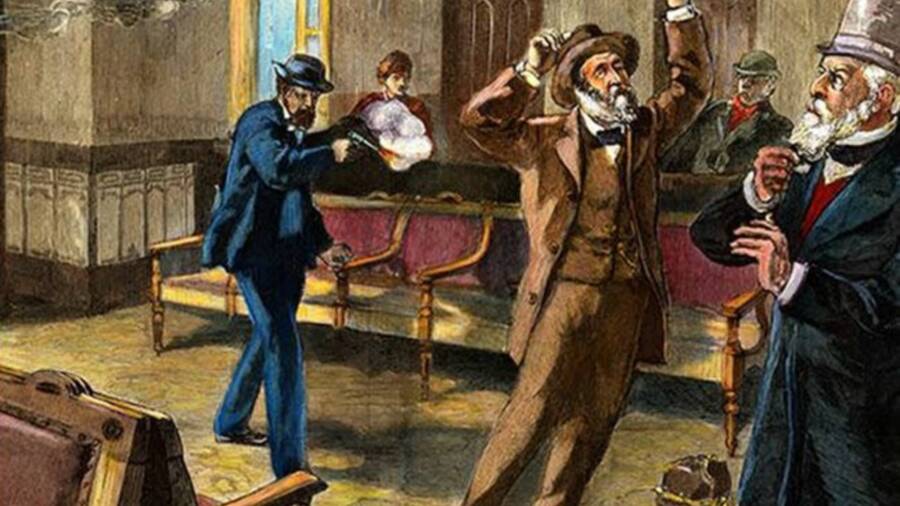James Garfield was shot in a Washington, D.C. train station by Charles J. Guiteau on July 2, 1881, but he didn't die from his injuries for another two months.

Public DomainA depiction of President James Garfield after he was shot, with his assassin, Charles Guiteau, being arrested in the background.
The assassination of James Garfield happened in the blink of an eye. On July 2, 1881, the president was walking arm-in-arm with Secretary of State James G. Blaine, preparing to catch a train to his alma mater, Williams College. Then, at 9:20 a.m., Blaine heard a shot ring out and felt Garfield twist at his side. “My God!” the president cried. “What is this?”
Garfield had been shot — twice. The first bullet grazed his elbow, and the second hit his lower back. Both had been fired by a man named Charles Guiteau, a mentally ill failed lawyer who believed the president had wronged him and that killing Garfield would save the country.
But Garfield didn’t die. At least, not at first.
Instead, the 49-year-old president lingered between life and death for 80 days. The doctors who tried to save his life likely made things worse, and James Garfield died in considerable agony on Sept. 19, 1881.
This is the story of James Garfield’s assassination, from Guiteau’s motives to the grisly aftermath.
How Charles Guiteau Decided To Kill The President
The story of James Garfield’s assassination begins with his assassin, 39-year-old Charles Guiteau of Illinois.
A failed lawyer, preacher, and bill collector, Guiteau’s mental health had declined considerably by the time Garfield was elected president on Nov. 2, 1880. In fact, Guiteau had come to believe that he had helped Garfield win the election by giving a handful of speeches on his behalf.

Public DomainCharles Guiteau, the man behind the assassination of James Garfield.
“On the principle of first come first served, I have faith that you will give this application favorable consideration,” Guiteau wrote, while asking to being appointed as the ambassador to Austria. Later, according to President Garfield: From Radical to Unifier by C.W. Goodyear, Guiteau wrote a follow-up letter stating that he would actually “prefer Paris to Vienna.”
Undeterred by Garfield’s lack of response, Guiteau took to badgering White House staff for a job. “Don’t you know who I am?” he’d shout. “I am one of the men that made Garfield president.”
Eventually, Guiteau came to believe that God wanted him to be the instrument of James Garfield’s assassination, so that Garfield’s vice president, Chester A. Arthur, could become the president. After weighing using dynamite or a knife, he settled on killing the president in “an American manner” — with a pistol. Guiteau borrowed money from a friend and purchased a short-barreled British Bulldog revolver that he believed would one day look good displayed in a museum.
“I know that,” Charles Guiteau remarked, “for the sake of harmony in the Republican Party, I had to kill him.”

Public DomainA drawing of the pistol Charles Guiteau used during the assassination of James Garfield. It’s since been lost.
And on July 2, 1881, Guiteau put his plan into action.
The Assassination Of James Garfield
By the time of his assassination, James Garfield had been president for just three months. It hadn’t been easy. Garfield, who had excelled as a Union general during the Civil War and a Republican congressman in its aftermath, had been elected as a “dark horse” candidate in 1880. And since taking office, his administration had been bogged down by various scandals.
July 2, 1881, then, seemed like a good reprieve from the pressures of Washington. Garfield was planning to take two of his sons to Williams College, his alma mater, for his college reunion.

Public DomainJames Garfield’s presidential portrait.
On the morning of James Garfield’s assassination, the president and his sons set out early for the Baltimore and Potomac Station, accompanied by James G. Blaine, the Secretary of State. By this point, Guiteau had been stalking Garfield for some time, but he didn’t have to guess about the president’s whereabouts that morning. As Goodyear noted, Garfield’s planned travel to Williams College had been reported in the newspaper.
The group of four — Blaine, eager to talk presidential business, had followed Garfield into the station — arrived at Baltimore and Potomac Station around 9:20 a.m. Guiteau was already there. He had his pistol in his pocket, alongside two letters. One, addressed to the White House, stated that “the president’s tragic death was a sad necessity, but it will unite the Republican Party and save the Republic.” The other, made out to Union General William T. Sherman, read: “I have just shot the President… I am going to the jail. Please order out your troops and take possession of the jail at once.”
Then, Guiteau put his plan into action.
Moments after Garfield arrived at the station, Guiteau stepped forward and fired two shots. The first hit Garfield in the elbow; the second hit the president in his lower back. Garfield cried out and fell forward as commuters piled onto Guiteau, easily detaining him.
One asked what “in God’s name” had been Guiteau’s purpose in shooting Garfield. Guiteau responded, “I am a Stalwart [a faction of the Republican party] and want Arthur [the vice president] for president.”

Public DomainAnother depiction of James Garfield’s assassination, from Harper’s Weekly.
Meanwhile, an especially horrified witness looked on — Robert Todd Lincoln, the Secretary of War and the son of President Abraham Lincoln, who had been assassinated less than 20 years before.
“My God,” Lincoln later exclaimed. “How many hours of suffering I have passed in this town.”
But the assassination of James Garfield hadn’t gone according to Guiteau’s plan. Though mortally wounded, Garfield was still alive.
The Agonizing Aftermath Of James Garfield’s Assassination
As Charles Guiteau was dragged off to jail, James Garfield was attended to by doctors. But their immediate actions likely made things worse.

Public DomainJames Garfield in 1881, the year of his assassination and death.
According to Goodyear, the first doctor on the scene gave Garfield brandy and ammonia salts before sinking his fingertips deep into the bloody hole in Garfield’s back, attempting to locate the bullet. This was repeated by multiple doctors who arrived at the scene, none of whom yet believed in the importance of sterile equipment or washing their hands.
Though the president was the “coolest man in the room,” according to Lincoln, he seemed resigned to his fate.
“I thank you doctor,” Garfield said, “but I am a dead man.”
Garfield was right, but it would take an agonizing 80 days for him to die. Meanwhile, his doctors were of little help. They gave the president quinine, morphine, alcohol, and even champagne, all of which caused him to vomit. Doctors also continued to search for the bullet in Garfield’s back, at one point enlisting the help of Alexander Graham Bell, who examined Garfield with an early version of a metal detector. But the president just wasted away.
The president lost nearly 100 pounds and was plagued by a high fever and abscesses on his body. Then, after roughly 11 weeks of terrible suffering, James Garfield died on Sept. 19, 1881, at the age of 49.

Public DomainJames Garfield’s casket lying in state at the Capitol Rotunda after his assassination.
At that point, the nation turned to his assassin, Guiteau.
In the immediate aftermath of James Garfield’s assassination, Guiteau continued to believe that he would be protected by Chester Arthur, who succeeded Garfield upon his death. “Arthur and all those men are my friends,” he told one police detective, “and I’ll have you made Chief of Police.”
But Arthur, for his part, seemed horrified at the idea of becoming president. “God knows I do not want the place I was never elected to!” he exclaimed to a visiting dignitary. He had little faith in his own abilities, and when Garfield seemed to rally, Arthur told a journalist: “As the president gets better, I get better.”
But when James Garfield died, Arthur’s worst fears were realized. He was sworn in as president at 2:15 a.m. on Sept. 20, 1881.
Two months later, Guiteau stood trial for James Garfield’s assassination. Despite claiming that the president’s death had been God’s will and more the fault of his doctors than Guiteau himself, the assassin was found guilty.
He was hanged on June 30, 1882.
After reading about the assassination of James Garfield, discover the mystery surrounding the death of President Zachary Taylor, who reportedly died after eating cherries and drinking cold milk. Or, learn about Leon Czolgosz, the anarchist who assassinated President William McKinley in 1901.





